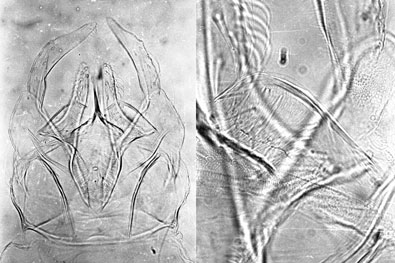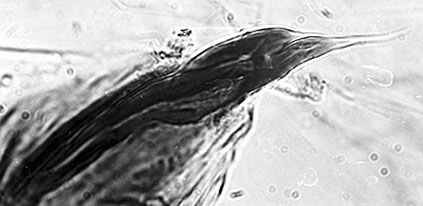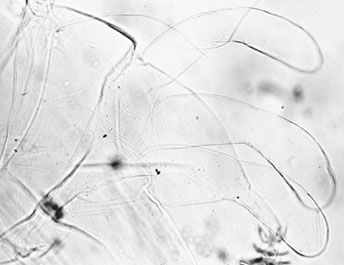New name for C. (Chaetolabis) macani sensu Wiederholm, 1979.
Previously Chaetolabis nr. atroviridis (sp. 2h) of Martin.Adult
Adult male and female originally described by Wiederholm (1979) as C. macani.
Several reared males from Ontario are either in the Sublette Collection at the University of Minnesota, or in the Canadian National Collection of Insects.
Based on the Wiederholm description, the following points can be made:
Male:
Dark species. AR 4.72 (4.61-4.86). Wing length 4.1 (3.9-4.3) mm. LR 1.38 (1.34-1.43); tarsi with a thin beard, easily broken off.
Frontal tubercles 11-14 µm long; Palp proportions (segs 2-5, µm) 86 : 315 : 291 : 350 P5/P4 1.20; P5/P3 1.11.
Tergite IX with 17 (14-20) setae in lighter fields.
Male hypopygium (left) and superior volsella (right) of Chaetolabis bitumineusAnal point narrow, particularly at base, Superior volsella broad with a strongly sclerotized hook, largely covered with microtrichia; setae of Inferior volsellae appear to be simple. Gonostyle narrowing in the distal third.Female:
Dark as male.
Wing length 4.6 (4.4-4.7) mm. LR 1.42 (1.39-1.47).
Antennal segment lengths (µm): 208 : 137 : 146 : 123 : 247. AR - 0.40; A5/A1 - 1.89.
Frontal tubercles about 23 (14-30) µm long.
Palp proportions (segs 2-5, in µm): 86 : 290 : 294 : 382 : P5/P4 1.30; P5/P3 1.32.
GpVIII with about 10 setae, GcIX with about 4 setae.
Pupa: (Largely based on European specimens) Length about 10.1-10.2 mm. Conspicuous pedes spurii B on segment II; hook row with about 70 hooks. Caudolateral spur of segment VIII with about 2 equally long spines, on North American specimen (below), but only one on European specimens.

Larva a medium to large thummi-type (length about 17.8-18.0 mm). Anterior ventral tubules shorter than posterior pair (ant. 1.24 mm; post. 1.32 mm). Anal tubules long (abt. 530-710 µm) with a median constriction, about 3.5-5.5 times longer than wide; ventral pair possibly slightly longer and thicker. Gula dark on posterior half, frontoclypeus slightly darkened.
Mentum (Fig. b) as in Chironomus; central tooth relatively broad with short parallel sides (or possibly diverge slightly), side teeth well developed (type III, or II), 4th laterals slightly reduced (type I-II).
Ventromentum (Fig. c) with about 40 striae. Pecten epipharyngis (fig. a) with about 16 irregular teeth.
Antenna (Fig. d) with AR about 1.8; basal segment about 3x as long as wide.
Mandible (Fig. e) with third inner tooth relatively well separated and darkened (type IIIC).

Long anal tubules with median constriction.Cytology: 3 polytene chromosomes with the modified thummi arm combination AB, CD, GEF.
Nucleolus subterminal in arm G. No nucleoli in other chromosomes.
Polymorphic in arms A, B, D and F chromosomes.
bitA1: as in Palearctic specimens; olive not obvious.
bitA2: Inversion of central part of the arm. as atrA2?
bitB1: Typical bands near the centromere still present but quite contracted in available material.
bitB2: Inversion of almost half the arm, beginning about 1/5 from centromere.
bitC1: as in Palearctic specimens, but typical bands (groups 3-4) not as obvious and may be nearer the centromere. as atrC2?
bitD1: Available specimens are heterozygous, but may be identical to the Palearctic sequence.
bitD2: Inversion of about 2/3 of the arm.
bitE1: as in Palearctic specimens, bands 10-13 obvious near the centromere.
bitF1: Available specimens heterozygous, but bands 20-23 obvious near the centromere; as in Palearctic specimens.
bitF2: Inversion of about the distal half of the arm. as atrF2?
bitG1: tandem fusion with arm E; subterminal nucleolus followed by two BRs.
Found: Ontario - Costello Creek, Algonquin Provincial Park, Nipissing Co. (45.58°; -78.32°); Beaver swamp near Dunrobin, Carleton Co. (45.45°; -76.00°); Cranberry Creek, abt. 1.5 km n. Kars, Carleton Co. (45.13°; -75.63°).
Also found in Palearctic Venetjärvi, FINLAND (Type locality); Sweden.
Pools with grass on the bottom.Morphology described by Wiederholm (1979) and Langton & Vallenduuk (2013). Cytology of European specimens described by Wülker (1989) (as C. macani), of Neartic specimens by Martin (2014).
The shared chromosome banding patterns and the extremely similar coxI DNA sequence to that of C. atroviridis suggests that the fusion of arm G with arm E has occurred relatively recently, as hybrids between the two species would almost certainly be partially or completely sterile due to abnormalities of chromosomal segregation during meiosis.
See also C. atroviridis (sp. 2i), C. ochreatus.[ Return to Index| Go to References ]

